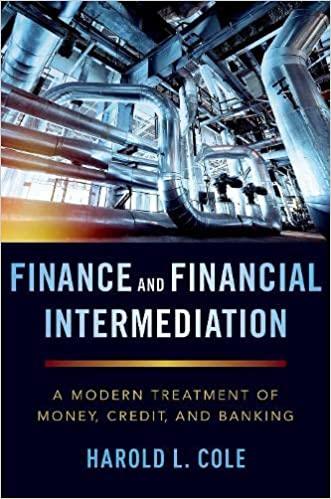Question
Question 1 The smaller the financial leverage of the firm, lower is the range (or variability) of its Earnings Per Share. a. True b. False
Question 1
The smaller the financial leverage of the firm, lower is the range (or variability) of its Earnings Per Share.
a. True
b. False
True
False
1 points
Question 2
Bike Inc.s capital structure contains 20 percent debt and 80 percent equity and the company pays 7 percent annual interest on its debt. Bike Inc.s stock has a beta of 1.0. Further, assume that the risk-free rate of interest equals 4 percent, and the expected return on the market portfolio equals 12 percent. The WACC for Bike Inc. will be _______ in the absence of taxes and will be ________ in the presence of a corporate marginal tax rate of 34%.
a. 11%; 10.52%
b. 13%; 12.31%
c. 9%; 8.25%
| a. | 11%; 10.52% | |
| b. | 9%; 8.25% | |
| c. | 13%; 12.31% |
1 points
Question 3
Costs associated with the requirement that management divert its attention away from strategically managing a corporation in favor of spending time with financial attorneys could be best described as
| a. | direct bankruptcy costs. |
| b. | indirect bankruptcy costs. |
| c. | mangerial-shareholder related agency costs. |
| d. | none of the above. |
| a. | mangerial-shareholder related agency costs. | |
| b. | indirect bankruptcy costs. | |
| c. | none of the above | |
| d. | direct bankruptcy costs. |
1 points
Question 4
The Globe Incorporated has EBIT of $20 million for the current year. On the firm balance sheet, there is $80 million of debt outstanding that carries a coupon rate of 8 percent. Investors seek a return of 12 percent on the firm, and the firm has a corporate tax rate of 40%. What is the present value of the firms tax shields, assuming the firms debt is perpetual?
| a. | $32,000,000 |
| b. | $30,000,000 |
| c. | $24,000,000 |
| d. | $6,400,000 |
| a. |
| |||
| b. |
| |||
| c. |
| |||
| d. |
|
1 points
Question 5
The smaller the financial leverage of the firm, higher is its expected Earnings Per Share.
a. True
b. False
True
False
1 points
Question 6
The present value of the tax shield represents the difference in the value of the Levered firm over the all-equity firm.
a. True
b. False
True
False
1 points
Question 7
The proposition that the market value of the firm is independent of its capital structure is true under what set of assumptions:
a. No corporate taxes yet there is a chance of bankruptcy
b. Corporate tax rate between 10% to 15% yet there is no chance of bankruptcy
c. No corporate taxes and no chance of bankruptcy
| a. | No corporate taxes and no chance of bankruptcy | |
| b. | Corporate tax rate between 10% to 15% yet there is no chance of bankruptcy | |
| c. | No corporate taxes yet there is a chance of bankruptcy |
1 points
Question 8
Molotov Cranberry Cocktail Corp finds that the value of the firm is equal to $200,000,000 with no debt. It knows that if it issues new debt, the value of the tax shield will be $4,000,000 while the value of the bankruptcy costs is $1,000,000. What will the value of Molotov be if it issues the debt?
| a. | $900,000 |
| b. | $203,000,000 |
| c. | $102,000,000 |
| d. | none of the above |
| a. | $203,000,000 | |||
| b. | none of the above | |||
| c. |
| |||
| d. | $900,000 |
1 points
Question 9
TransMetro Incorporated has EBIT of $1 million for the current year. On the firm balance sheet, there is $6 million of debt outstanding that carries a coupon rate of 15 percent. Investors seek a return of 20 percent on the firm, and the firm has a corporate tax rate of 40%. What is the present value of the firms tax shields?
| a. | $2,000,000 |
| b. | $2,200,000 |
| c. | $2,400,000 |
| d. | $2,700,000 |
| a. |
| |||
| b. | $2,400,000 | |||
| c. | $2,700,000 | |||
| d. | $2,000,000 |
1 points
Question 10
Given the presence of bankruptcy costs as well as corporate taxes with deductibility of interest for tax purposes, the optimal Debt to Equity ratio for a firm will be
a. Debt Equity of almost 100%
b. Debt/Equity ratio of 0%
c. Debt/Equity ratio between 0% and 100%
| a. | Debt Equity of almost 100% | |
| b. | Debt/Equity ratio between 0% and 100% | |
| c. | Debt/Equity ratio of 0% |
Step by Step Solution
There are 3 Steps involved in it
Step: 1

Get Instant Access to Expert-Tailored Solutions
See step-by-step solutions with expert insights and AI powered tools for academic success
Step: 2

Step: 3

Ace Your Homework with AI
Get the answers you need in no time with our AI-driven, step-by-step assistance
Get Started


